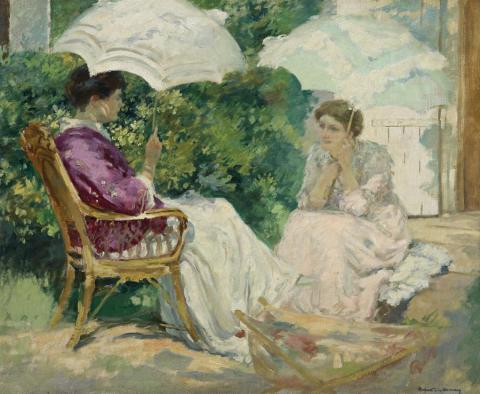CHATTING, c.1910-15 also known as 'Causerie'
RUPERT BUNNY
oil on canvas
60.5 x 73.0 cm
signed lower right: Rupert C.W. Bunny
inscribed on stretcher verso: CHATTING
Art Gallery of New South Wales, Sydney, purchased 1923 (label attached verso)
Thirty Victoria Street, Sydney
Private collection, Sydney, acquired from the above in 1985
Tom Silver Fine Art, Sydney
Private collection, Melbourne
Exposition Rupert C. W. Bunny, Galeries Georges Petit, Paris, 16–31 March 1917, cat. 10 (as 'Causerie')
Exhibition of Paintings by Rupert C. W. Bunny, Fine Art Society's Gallery, Melbourne, 15–27 November 1922, cat. 25
Exhibition of Oil Paintings by Rupert C. W. Bunny, Anthony Hordern and Sons Limited, Sydney, 2–31 May 1923, cat. 25
Rupert Bunny Exhibition, National Gallery of Victoria, Melbourne, 1 October – 10 November 1946, cat.1
100 Years of Australian Painting, Art Gallery of New South Wales, Sydney, 19 April – 17 May 1948, cat. 18
Rupert Bunny Retrospective, Newcastle City Art Gallery, New South Wales, 31 July – 3 September 1968, cat. 10
Rupert Bunny Loan Exhibition, Manly Art Gallery, Sydney, 21 September – 6 October 1968, cat. 5
Aspects of Australian Art: Art Gallery of New South Wales Travelling Art Exhibition 1976, Art Gallery of New South Wales, Sydney, 1976–77, cat. 14
Geffroy, G., 'Rupert Bunny' [catalogue introduction], Exposition Rupert C. W. Bunny, Galeries Georges Petit, Paris, 1917
Sydney Morning Herald, 2 May 1923, p. 4
Sun, Sydney, 2 May 1923
Daily Telegraph, Sydney, 3 May 1923, p. 6
Sunday Times, Sydney, 6 May 1923, p. 13
Australasian, Melbourne, 12 May 1923, p. 942
Turnbull, C., and Buesst, T., The Art of Rupert Bunny, Ure Smith, Sydney, [1948], p. 70
Badham, H., A Study of Australian Art, Currawong Publishing, Sydney, 1949, pl. 28 (illus.)
Smith, B., A Catalogue of Australian Oil Paintings in the National Art Gallery of New South Wales, 1875–1952, Art Gallery of New South Wales, Sydney, 1953, pp. 36-7
Thomas, D., Art Gallery of New South Wales Quarterly, vol. 12, no. 1, October 1970, pp. 554, 563 (illus.)
Thomas, D., Rupert Bunny, Lansdowne Press, Melbourne, 1970, p. 68, cat. 0166
Lindsay, R., Aspects of Australian Art, Art Gallery of New South Wales, Sydney, 1976, cat. 14 (illus.)
Towards the end of the first decade of the twentieth century and into the years of the Great War, Rupert Bunny turned to painting works of enchanting, secluded beauty, of women relaxing in gardens filled with dappled sunlight. Chatting is a classic example. It was included in Bunny's solo exhibition in Paris in 1917, when Gustave Geffroy, one of the leading French critics of the day wrote of Bunny's paintings expressing 'the luminous joy of daylight, ... the pleasure of living in the shadow of trees looking out on a festival of sunshine.' Bunny, he declared, was 'an observer of truth and a poet of the world of dreams.'1 As the 'war to end all wars' tore Europe and the belle époque to pieces, Bunny sought beauty in the intimate moments of the everyday. Even though hailed as 'a painter of beautiful women', the real subject of his art was light and its sensuous play across figure and dress.2 The Georges Petit exhibition in 1917 was very well received by French and English critics alike. The British-Australasian described it as 'one of the biggest successes of the season, two pictures having been purchased by the French State for the Luxembourg Museum, while many sales were made to private buyers.'3
When Bunny brought a selection of these works to Australia in 1922 for exhibition, buyers from public collections were again to the fore. In Melbourne the Trustees of the National Gallery of Victoria added Girl at a Window, c1917 to its collection through the Felton Bequest. In Sydney, the Art Gallery of New South Wales chose two paintings, Chatting and The Garden Bench. The writer for the Sydney Morning Herald thought Chatting to be 'a composition of winning charm ... The distribution of light is true to nature, and the colour of a plum-coloured silk bodice is fascinating.'4 ;The Sunday Times said Chatting was 'well worthy to represent Mr. Bunny'.5 Private collectors also bestowed their favours on Bunny.
The chief model in this and many of these paintings was Bunny's wife, the beautiful Jeanne-Heloise. She is readily identified by her dark hair and retroussé nose. The mood of the painting is also characteristically Bunny, relaxed moments of 'dolce far niente', the favoured indulgence of doing sweet nothing. It was a title Bunny gave to one of his best paintings, Dolce farniente of c1897, in a private Melbourne collection. Chatting was selected by Bunny to be included in his 1946 retrospective exhibition held at the National Gallery of Victoria. It was the first retrospective given by the Gallery to honour a living Australian artist and was a huge success.
1. Geffroy, G., 'Rupert Bunny' [catalogue introduction], Exposition Rupert C. W. Bunny, Galeries Georges Petit, Paris, 1917
2. Moore, W., Life, Melbourne, 1 September 1911, p. 249. Bunny occasionally gave the name 'sun bath' to these paintings, as in the grand c1913 painting in the collection of the Bendigo Art Gallery, Victoria.
3. 'Australian Artists in Paris', British-Australasian, London, 11 March 1920, p. 12
4. Sydney Morning Herald, 2 May 1923, p. 4
5. Sunday Times, Sydney, 6 May 1923, p. 13
DAVID THOMAS
